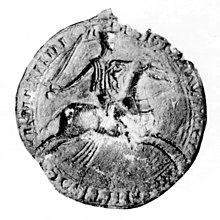William I, Count of Holland
| William I | |
|---|---|
 Effigy of William on his seal | |
| Count of Holland | |
| Reign | 1203 – 4 February 1222 |
| Predecessor | Ada |
| Successor | Floris IV |
| Born | c. 1167 The Hague |
| Died | 4 February 1222 |
| Burial | |
| Spouse | |
| Issue and others... | |
| House | Holland |
| Father | Floris III, Count of Holland |
| Mother | Ada of Huntingdon |
William I (c. 1167 – 4 February 1222) was count of Holland from 1203 to 1222. He was the younger son of Floris III and Ada of Huntingdon.
Early life[edit]

William was born in The Hague, but raised in Scotland. He participated in the Third Crusade under Emperor Frederick I alongside his father, Floris, and his uncle Otto of Bentheim.[1] He started a revolt against his brother, Dirk VII and became count in Friesland after a reconciliation. Friesland was considered a part of Holland by the counts of Holland. His niece Ada inherited Holland in 1203, but William refused to accept this. After a war of succession, known as the Loon War (1203–1206), William won the county. Ada and her husband, Louis II of Loon, were supported by the bishop of Liège, bishop of Utrecht, and the count of Flanders. William was supported by the duke of Brabant and by the majority of the Hollanders.
Countship[edit]
Emperor Otto IV acknowledged him as count of Holland in 1203 because he was a supporter of the Welfs. He and many others changed allegiance to Frederick II after the battle of Bouvines in 1214. He took part in a French expedition against King John of England. The pope excommunicated him for this. Possibly because of this, William then became a fervent crusader and by this his excommunication was lifted. He campaigned in Prussia. In Europe, he came to be called William the Crazy for his chivalric and reckless behaviour in battle. On his way to the Egypt, he commanded a joined force of Frisian, Dutch, Flemish and Rhenish crusaders that helped the Portuguese conquered the city of Alcácer do Sal from the Almohads as it is noted in the De itinere Frisonum and the Gesta crucigerorum Rhenanorum.[2] William helped to conquer the city of Damietta during the Fifth Crusade.
There were great changes in the landscape of Holland in the end of the 12th and during the 13th century. Many colonists bought land to turn the swamps into polders. Most of the swamps had been sold, and irrigation had started during the reign of William. Huge infrastructural works were done; the island called Grote Waard was enclosed with dikes all around and a dam was built at Spaarndam. New governmental bodies were created, the so-called water boards, which were charged with the task of protecting the polders against ever-present threat of flooding. Count William granted city rights to Geertruidenberg in 1213, to Dordrecht in 1217, to Middelburg in 1220 and perhaps also to Leiden. In this way he gave an impulse to trade.
Family[edit]
Count William was married twice. First, he was married in 1197 at Stavoren to Adelaide of Guelders, daughter of Otto I, Count of Guelders and Richarde of Bavaria. They had the following children:
- Floris IV (1210 – 19 July 1234), who succeeded William I as count of Holland
- Otto (died in 1249), regent of Holland in 1238–1239, bishop of Utrecht
- William (died in 1238), regent of Holland in 1234–1238
- Richardis (died in 1262)
- Ada, abbess at Rijnsburg in 1239[3]
Adelaide died on 12 February 1218 while William was away on crusade. In 1220 Count William married Marie of Brabant, widow of Emperor Otto IV.
References[edit]
- De Boer, Dick; Cordfunke, Erik (1995), Graven van Holland : portretten in woord en beeld (880-1580), Zwolle: Walburg Pers, pp. 29–30, ISBN 978-90-6011-915-0
- ^ The Crusade of Frederick Barbarossa, The History of the Expedition of The Emperor Frederick and Related Texts, trans. G.A. Loud (Ashgate, Farnham, 2010), p.49.
- ^ Lucas Villegas-Aristizábal, 'Was the Portuguese Led Military Campaign against Alcácer do Sal in the Autumn of 1217 Part of the Fifth Crusade', Al-Masaq 31.1 (2019): 59-64. https://doi.org/10.1080/09503110.2018.1542573; Lucas Villegas-Aristizábal, 'A Frisian Perspective on Crusading in Iberia as Part of the Sea Journey to the Holy Land, 1217–1218', Studies in Medieval and Renaissance History, 3rd Series 15 (2018, Pub. 2021): 81-87, 92, 106, 120-123. https://www.academia.edu/37460772/A_Frisian_Perspective_on_Crusading_in_Iberia_as_part_of_the_Sea_Journey_to_the_Holy_Land_1217_1218
- ^ djr (2019-09-17). "Digitaal Vrouwenlexicon van Nederland". resources.huygens.knaw.nl (in Dutch). Retrieved 2019-10-05.
- 1160s births
- 1222 deaths
- Nobility from The Hague
- People excommunicated by the Catholic Church
- Dutch monarchs
- Dutch people of Scottish descent
- Counts of Holland
- People of the Northern Crusades
- Christians of the Third Crusade
- Christians of the Fifth Crusade
- People of the Reconquista
- Burials at Rijnsburg Abbey
- 13th-century people from the Holy Roman Empire
- 13th-century counts in Europe
